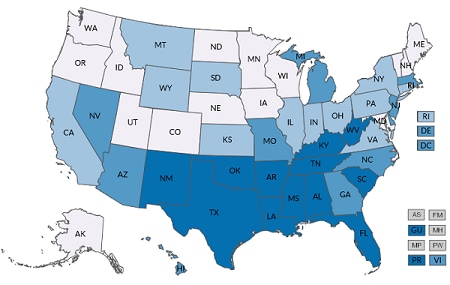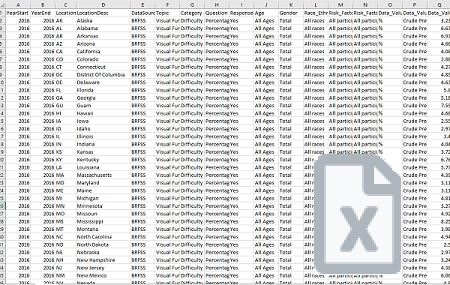Medicare
Medicare Claims at a Glance
| Medicare Part B Fee for Service (FFS) Claims | |
|---|---|
| Description | 100% Medicare Part B FFS medical claims |
| Sample | Full population of Medicare FFS beneficiaries |
| VEHSS Topics Included |
|
| Approximate Size | 66 million persons |
The VEHSS analysis of Medicare data includes all reimbursed claims for all Medicare beneficiaries enrolled in traditional FFS plans. Patients enrolled in Medicare Advantage (MA) plans are not currently included in the VEHSS Medicare analysis but will be included in future updates. As of 2020, about half of Medicare beneficiaries carried MA insurance.
Medicare, including FFS and MA, covers ophthalmologic services for nearly the entire US population aged 65 and older and people younger than 65 who have received social security benefits as a result of disability for 24 months; people who have end-stage renal disease and receive dialysis or a kidney transplant; and people who have amyotropic lateral sclerosis (ALS). Like others with a disability, people with US-defined blindness (a best corrected acuity of 20/200 or worse in the better-seeing eye) become eligible for Medicare 24 months after qualifying for federal disability benefits. Medicare FFS does not cover certain services, including optometry care, glasses or routine eye exams in the absence of a diagnosis.
Please see the Research Data Assistance Center website for a description of each file.
The VEHSS team calculated prevalence of diagnosed eye and vision disorders and the proportion of patients receiving covered eye care services in Medicare FFS claims based on the presence of ICD9 and ICD10 diagnosis codes and CPT procedure codes on any patient claim during the year of observation.
VEHSS reports summary prevalence and counts for the topics and categories listed for each geographic level and stratification factor listed below:
Available Geographic Levels
| National | State | County |
|---|---|---|
| Included Stratification Factors (State and National Estimates) | |
|---|---|
| Age Group |
|
| Gender |
|
| Race/Ethnicity |
|
| Risk Factors |
|
| Data Type |
|
A detailed description of the analytical steps is described in the report “VEHSS Claims & Registry Data Analysis Plan [PDF – 579 KB] .”
Full analysis documentation is included in the “VEHSS Medicare Data Report [PDF – 1.5 MB] .”
The VEHSS analysis of Medicare claims is subject to several potential limitations:
- Medicare claims are intended for billing purposes only. Diagnosis information included on claims is intended to justify payment. Therefore, diagnosis data on claims may suffer from bias or limited detail.
- Medicare FFS does not cover all healthcare services, such as routine eye exams or optometry care. Medicare patients may receive these services using a different payer, and thus these services are not captured in Medicare FFS claims.
- Patients may be insured by multiple insurers, such as a supplemental, medigap or Medicare managed care plans. Thus, even normally covered ophthalmology services may not be indicated in FFS claims if services were reimbursed by another plan.
- Many Medicare patients move seasonally. We report patient residence using the last location of observation. This may skew patient numbers towards “sun belt” states.
- Medicare is not nationally representative for individuals younger than 65 years and includes only persons who are eligible for the reasons listed above. These patients may obtain Medicare coverage due to medical need, such as legally recognized disability, or other specially defined benefit, such as end-stage renal disease. Individuals who become disabled for reasons of blindness cannot be distinguished from others who are disabled unless their visual condition of low vision and blindness is diagnosed in their medical claims.
- Medicare FFS is a complete population of Medicare FFS beneficiaries, including all FFS beneficiaries younger than 65 and those 65 and older. For those ages 65 and older, the data exclude beneficiaries with MA plans, people who defer Medicare coverage, or services paid out of pocket.
[1] US Census Bureau. Profile America facts for features: CB17-FF.08. Washington, DC: Economics and Statistics Administration; 2017. https://www.census.gov/content/dam/Census/newsroom/facts-for-features/2017/cb17-ff08.pdf. Accessed March 1, 2018.
[2] State Health Facts: Menlo Park, CA: Kaiser Family Foundation. https://www.kff.org/statedata/. Accessed March 1, 2018.

